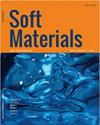Cluster of D-maltose clicked to β-cyclodextrin: preparation and its application as a biocompatible drug delivery nanovehicle
IF 1.4
4区 材料科学
Q4 MATERIALS SCIENCE, MULTIDISCIPLINARY
引用次数: 0
Abstract
ABSTRACT In the current study, it was tried to design and synthesize a new derivative of β-cyclodextrin (β-CD) as a result of reaction with D-maltose (β-CD-M) to compare and investigate its capability as an anticancer drug nanocarrier. The success in the β-CD-M synthesis was validated via common characterization techniques: nuclear magnetic resonance (NMR), Fourier transform infrared spectroscopy (FT-IR), and scanning electron microscopy (SEM). The SEM results indicate that the obtained β-CD-M molecule has a crystalline structure with a size of less than 100 nm. In the following, methotrexate (MTX) and doxorubicin (DOX) as the model of anticancer drugs were separately loaded in β-CD-M and their release profile was obtained. The outcome of the cytotoxic assay against MCF 10A cells indicated that β-CD-M is biocompatible and could be used as a drug carrier. Overall, from the obtained results, the synthesized biocompatible β-CD-M with more drug loading capacity and a controlled release profile in comparison to unmodified β-CD could be proposed as a potential nanocarrier for anticancer drug delivery.d -麦芽糖簇与β-环糊精的结合:制备及其作为生物相容性药物递送纳米载体的应用
摘要本研究设计并合成了一种与d -麦芽糖(β-CD- m)反应的新型β-环糊精(β-CD)衍生物,并对其作为抗癌药物纳米载体的性能进行了比较研究。通过核磁共振(NMR)、傅里叶变换红外光谱(FT-IR)和扫描电子显微镜(SEM)等常用表征技术验证了β-CD-M合成的成功。SEM结果表明,所得β-CD-M分子具有小于100 nm的晶体结构。将甲氨蝶呤(MTX)和阿霉素(DOX)作为抗癌药物模型分别装入β-CD-M中,获得其释放谱。对mcf10a细胞的细胞毒性实验结果表明,β-CD-M具有生物相容性,可作为药物载体。综上所述,合成的具有生物相容性的β-CD- m与未修饰的β-CD相比,具有更大的载药量和控释特性,可作为潜在的抗癌药物纳米载体。
本文章由计算机程序翻译,如有差异,请以英文原文为准。
求助全文
约1分钟内获得全文
求助全文
来源期刊

Soft Materials
工程技术-材料科学:综合
CiteScore
2.90
自引率
0.00%
发文量
21
审稿时长
2.2 months
期刊介绍:
Providing a common forum for all soft matter scientists, Soft Materials covers theory, simulation, and experimental research in this rapidly expanding and interdisciplinary field. As soft materials are often at the heart of modern technologies, soft matter science has implications and applications in many areas ranging from biology to engineering.
Unlike many journals which focus primarily on individual classes of materials or particular applications, Soft Materials draw on all physical, chemical, materials science, and biological aspects of soft matter. Featured topics include polymers, biomacromolecules, colloids, membranes, Langmuir-Blodgett films, liquid crystals, granular matter, soft interfaces, complex fluids, surfactants, gels, nanomaterials, self-organization, supramolecular science, molecular recognition, soft glasses, amphiphiles, foams, and active matter.
Truly international in scope, Soft Materials contains original research, invited reviews, in-depth technical tutorials, and book reviews.
 求助内容:
求助内容: 应助结果提醒方式:
应助结果提醒方式:


